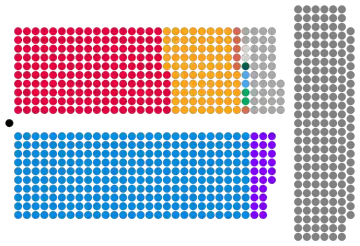
An election apportionment diagram is the graphic representation of election results and the seats in a plenary or legislative body. The chart can also be used to represent data in easy to understand terms, for example by grouping allied parties together.
Background
Votes in an election are often represented using bar charts or pie charts, often labeled with the corresponding percentage or number of votes.[1] The apportionment of seats between the parties in a legislative body has a defined set of rules, unique to each body. As an example, the Senate of Virginia says,
The Clerk of the Senate, after the election of Senators, shall assign desks to the individual Senators with the Senators elected as members of the majority party in the Senate in the chamber area beginning at the north side of the chamber until all such desks have been assigned, and then the Senators elected as members of the minority party in the Senate, and then any Senator not elected as a member of the two major political parties.[2]

Instead of using a bar or pie chart, the apportionment of seats between the parties in a legislative body such as a parliament can be represented more clearly by displaying the individual representatives of each party as dots in a pattern, because the number of representatives is also significant, and is easily understood visually. The dots are typically coded according to the political color of the respective parties.[3] This was traditionally presented as a seating chart of a plenary hall, but can also be represented in a more abstract fashion which more loosely corresponds to the seating arrangement in a legislature, for example a form of half-donut chart as an abstract representation of a hemicycle, or a stylized representation of the Westminster Parliament, showing government, opposition, speaker and crossbenchers. In Germany, the order of the bars usually corresponds from left to right to the placement of the parties in the previous election and is thus based on the order given on the ballot, which is regulated in Section 30 of the Federal Electoral Act.[4]
These charts can also be used to represent data in easy to understand terms.[5] An example of this is politicians’ responses to the Orlando shootings.[6]
Gallery
 Schematic diagram of the House of Lords, showing government, opposition, cross-bench and speaker, without being an accurate representation of the seating layout
Schematic diagram of the House of Lords, showing government, opposition, cross-bench and speaker, without being an accurate representation of the seating layout Stylised U-shaped diagram meant to depict the layout of the Northern Ireland Assembly
Stylised U-shaped diagram meant to depict the layout of the Northern Ireland Assembly An election apportionment diagram closely mirroring the actual seating layout of the Bundestag
An election apportionment diagram closely mirroring the actual seating layout of the Bundestag
See also
References
- ↑ An example of this can be seen in the BBC Coverage of the 2019 parliamentary election (Dunford, Daniel; et al. (December 13, 2019). "Election results 2019: Analysis in maps and charts". News. BBC.)
- ↑ "Seating Chart". Senate of Virginia. 2020. Retrieved April 13, 2020.
- ↑ Drum, Kevin (November 14, 2004). "Red States and Blue States ... Explained!". The Washington Monthly. Retrieved November 4, 2010.
- ↑ "Reihenfolge der Wahlvorschläge auf dem Stimmzettel – Der Bundeswahlleiter" [Order of nominations on the voting slip]. Der Bundeswahlleiter (in German). November 4, 2018.
- ↑ Pandey, Rajeev (September 2, 2019). "Parliament chart in Tableau". Vizart Pandey. Retrieved August 18, 2020.
- ↑ shivaraj (July 12, 2016). "Orlando Killings: Democrats vs. Republicans". Tableau Public.
Further reading
- Bradberry, Brent A. (February 1992). "A Geometric View of Some Apportionment Paradoxes" (PDF). Mathematics Magazine. 65 (1): 3–17. doi:10.1080/0025570X.1992.11995970. JSTOR 2691355.
- Tsai, Yun-Da (October 8, 2018). "Latvia Parliamentary Elections Deliver Pro-Russia, Anti-Establishment Parties Victory". IR Insider. International Relations Society at NYU.
External links
 Media related to Election apportionment diagrams at Wikimedia Commons
Media related to Election apportionment diagrams at Wikimedia Commons- Parliament diagram creation tool
- THE HOUSE OF COMMONS AND ITS MEMBERS
- House seating plan